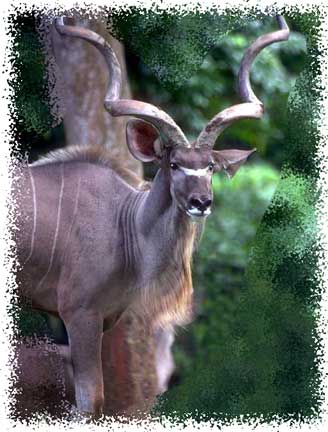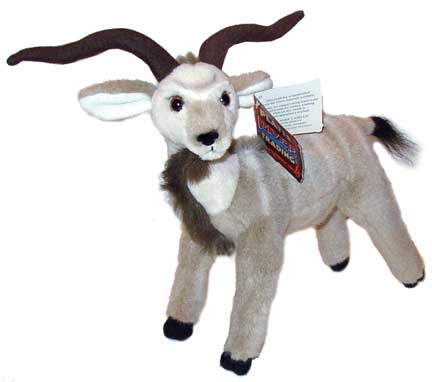
Greater Kudu Facts
Find Kudu stuffed animals, facts and information at Animals N More. The Kudu stuffed animal shown was made by Platte River Trading Company.
Antelopes are famous for their speed, grace and good looks. They come in many shapes and sizes. The Greater Kudu,  Tragelaphus strepsiceros, a large creature with lengthy corkscrew horns, is one of the most noble-looking antelopes in all of Africa. Sometimes called "the antelope king," it has been described as the finest of all its tribe.
Tragelaphus strepsiceros, a large creature with lengthy corkscrew horns, is one of the most noble-looking antelopes in all of Africa. Sometimes called "the antelope king," it has been described as the finest of all its tribe.
The kudu is shy and elusive. When threatened, it will often run away. It can be found in the bush or in scrub-covered rocky hills, and deciduous woodlands. It is helped by the camouflage of its striped gray coat, which is difficult to see in the bush. It is a graceful leaper and has a keen sense of hearing. It is also a good swimmer and can outdistance its pursuers in the water.
The glory of the kudu bull is its magnificent horns. They may reach a length of 70 inches or more, and are fashioned in the form of long, wide, open spirals of 2-1/2 turns; cows are hornless. This handsome animal stands almost five feet at the shoulder, and bulls weigh between 500 and 700 pounds. The coat is grayish brown in color with vertical white stripes along the sides of the body. There is a crest of long hair along the spine. The face is bedecked with white markings on the nose, cheeks and a chevron of white hair between the eyes. The kudu's ears are large, the tail moderately long and tufted; there is a fringe of long hair on the throat of both male and female.
 Except during the breeding season, when small herds or family groups are the rule, the sexes live apart, and the males keep bachelor quarters. Bulls fight during the rut, and occasionally this results in fatally locked antlers. The deep, hoarse barks or "bugles" of the kudus are the loudest sounds made by any antelope.
Except during the breeding season, when small herds or family groups are the rule, the sexes live apart, and the males keep bachelor quarters. Bulls fight during the rut, and occasionally this results in fatally locked antlers. The deep, hoarse barks or "bugles" of the kudus are the loudest sounds made by any antelope.
Cows usually have one calf at a time, seven or eight months after mating. Kudus live 7 to 8 years in the wild and have survived in captivity for over 15 years.
The range of the greater kudu and its local relatives extends from Ethiopia to South Africa. In the bush and rocky hill country which it loves, its favorite food is leaves, grasses and wild fruits.
The Greater Kudu stuffed animal shown above was made by the Platte River Trading Company and is a true rendition of the actual animal. Platte River Trading closed its doors in 2015. We hope you have enjoyed finding Kudu stuffed animals, facts and information at the Forest Cottage Zoo.



